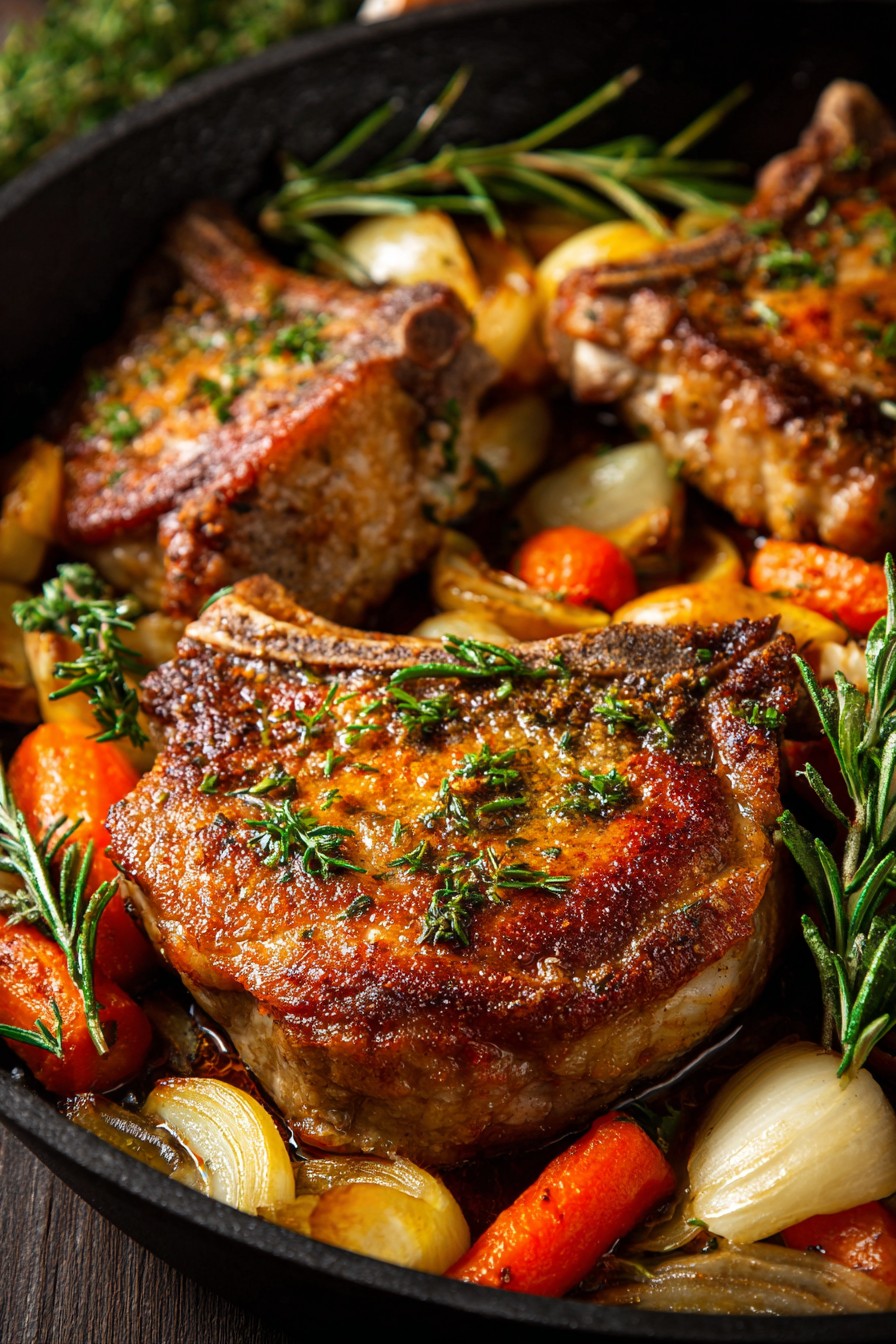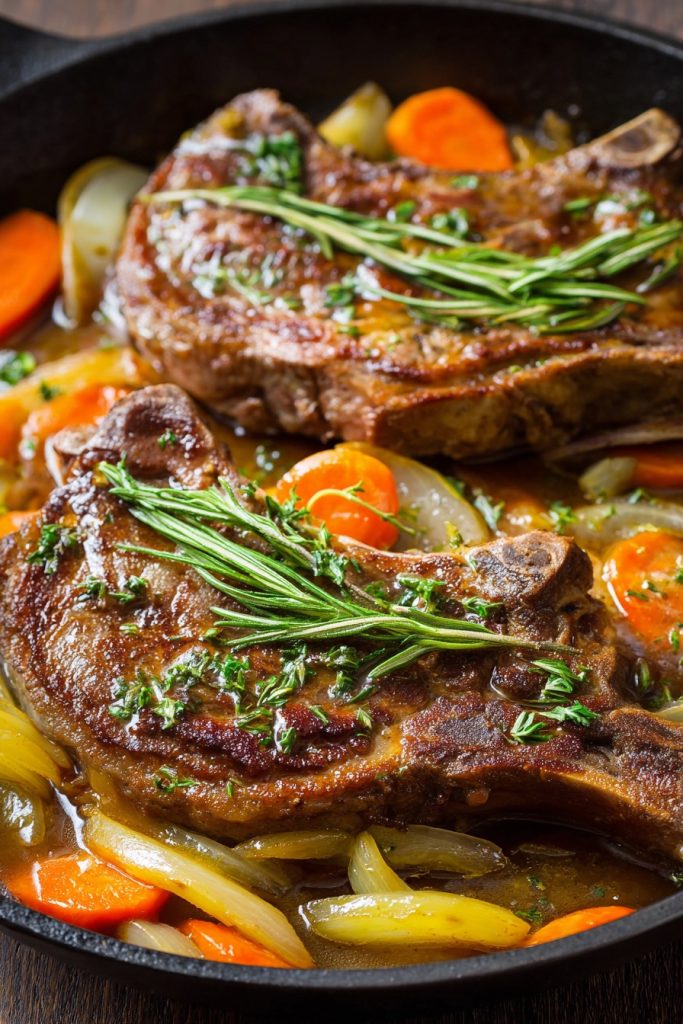Candlelight dances across the table as evening settles around us, and in this quiet space between day and night, there exists the perfect opportunity to create something beautiful together. Creating these oven-baked pork steaks feels less like cooking and more like weaving a tapestry of flavors and textures designed to nourish both body and soul, transforming an ordinary evening into a cherished memory.
Why This Recipe Works
- The gentle oven heat coaxes the pork steaks to perfect tenderness without the harshness of direct flame, creating a texture that melts like whispered secrets across your tongue
- Our carefully balanced marinade of olive oil, garlic, and fresh herbs penetrates deep into the meat, ensuring every bite carries the full symphony of flavors from surface to center
- The addition of aromatic vegetables roasting alongside the pork creates a natural sauce that marries all the elements together in a harmonious culinary embrace
- Resting the steaks after cooking allows the juices to redistribute throughout the meat, resulting in that perfect, succulent bite that speaks of patience and care
- The entire process unfolds with such graceful simplicity that you can focus on the company rather than complicated techniques, making the cooking part of the romantic experience itself
Ingredients
- 2 bone-in pork steaks, about 1 inch thick (approximately 1.5 pounds total)
- 3 tablespoons extra virgin olive oil, divided
- 4 cloves garlic, minced until fragrant
- 1 tablespoon fresh rosemary, finely chopped
- 2 teaspoons fresh thyme leaves
- 1 teaspoon kosher salt
- ½ teaspoon freshly ground black pepper
- 1 large yellow onion, sliced into half-moons
- 2 medium carrots, peeled and cut into 1-inch chunks
- ½ cup chicken broth
- 2 tablespoons unsalted butter, cut into small pieces
- 1 tablespoon fresh parsley, chopped for garnish
Equipment Needed
- Large oven-safe skillet or baking dish
- Small mixing bowl
- Measuring spoons
- Cutting board and sharp knife
- Meat thermometer
- Tongs
- Aluminum foil
Instructions

Prepare the Aromatic Marinade
In a small bowl that feels comfortable in your hands, combine two tablespoons of golden olive oil with the minced garlic, letting their fragrances mingle like old friends reunited. Add the freshly chopped rosemary and thyme leaves, their herbal notes rising to greet you like a gentle morning breeze through an open window. Sprinkle in the kosher salt and freshly ground black pepper, then stir everything together until the mixture becomes a fragrant paste that promises depth and complexity. Take a moment to appreciate how these simple ingredients, when combined with intention, create something greater than their individual parts—much like how two separate lives can weave together into a beautiful shared story.
Season and Rest the Pork Steaks
Pat the pork steaks dry with paper towels, this simple act of preparation creating the foundation for a beautifully seared surface later. Using your hands or a brush, generously coat both sides of each steak with the herb and garlic mixture, massaging it into the meat with the same tender care you might show a loved one’s shoulders after a long day. Let the steaks rest at room temperature for thirty minutes—this waiting period allows the flavors to penetrate deep into the meat while the pork comes to a more even temperature, ensuring more consistent cooking. As they rest, you might set the table, select music, or simply enjoy a glass of wine together, making this pause part of the evening’s rhythm rather than an interruption.
Create the Vegetable Foundation
Preheat your oven to 375°F, that perfect medium heat that cooks gently rather than aggressively. While it warms, heat your oven-safe skillet over medium-high heat and add the remaining tablespoon of olive oil, watching as it shimmers when properly heated. Add the sliced onions and carrot chunks, sautéing them for about five minutes until the onions become translucent and the carrots just begin to soften at the edges. This vegetable bed will cradle the pork steaks during their oven journey, absorbing their juices while contributing their own sweetness to the developing sauce beneath.
Initial Searing and Oven Transfer
Push the vegetables to the perimeter of the skillet, creating space in the center for the pork steaks. Place the seasoned steaks in the hot center and sear for two to three minutes per side, until they develop a beautiful golden-brown crust that will seal in all those precious juices. You’ll know they’re ready to turn when they release easily from the skillet surface—if they resist, give them another thirty seconds to develop that proper sear. Once both sides are perfectly colored, arrange the vegetables around the steaks, pour in the chicken broth, and dot everything with those small pieces of butter that will melt into a luxurious sauce.
The Gentle Oven Transformation
Carefully transfer the entire skillet to your preheated oven and bake for twenty-five to thirty minutes, until the pork steaks reach an internal temperature of 145°F when measured at their thickest part. The aroma that will begin to fill your kitchen is nothing short of magical—the garlic and herbs mingling with the pork’s natural sweetness, the vegetables softening and caramelizing at the edges. During this time, the broth, butter, and meat juices combine to create a simple but exquisite pan sauce that needs no further embellishment beyond perhaps a sprinkle of fresh parsley at the end.
The Essential Resting Period
Using oven mitts, remove the skillet from the oven and transfer the pork steaks to a clean cutting board or platter, tenting them loosely with aluminum foil. This fifteen-minute resting period is non-negotiable—it allows the muscle fibers to relax and reabsorb the juices that have been driven toward the center during cooking. Meanwhile, the vegetables continue to steep in the pan sauce, becoming even more tender and flavorful. Use this quiet interlude to light candles, pour wine, or simply stand together in the kitchen, anticipating the meal to come.
Final Plating and Serving
After their proper rest, arrange the pork steaks on warmed plates alongside the roasted vegetables, spooning that glorious pan sauce over everything until it glistens under the soft lighting. The final sprinkle of fresh parsley adds both visual appeal and a bright, clean note that cuts through the richness of the dish. Serve immediately while everything is at its peak—the pork tender and juicy, the vegetables sweet and yielding, the sauce a perfect balance of all the elements that have come together in your oven’s gentle embrace.
Tips and Tricks
For those seeking to elevate this already beautiful dish to even greater heights, consider these additional touches that transform the good into the unforgettable. When selecting your pork steaks, look for those with a nice marbling of fat throughout—this intramuscular fat will render during cooking, basting the meat from within and creating that sublime tenderness we all cherish. If you have the luxury of time, consider marinating the steaks for several hours or even overnight in the refrigerator; this extended acquaintance allows the flavors to penetrate even deeper, creating a more complex flavor profile throughout each bite.
Temperature control is everything when working with pork—invest in a reliable instant-read thermometer and use it faithfully. While 145°F is our target for perfect doneness, remember that the temperature will continue to rise about five degrees during the resting period, so removing the steaks at 140°F ensures they won’t overcook. If you find your pork steaks are thinner or thicker than the recommended one inch, adjust the cooking time accordingly—approximately three to four minutes less or more per half-inch of thickness difference.
The quality of your ingredients matters tremendously here—since this recipe relies on relatively few components, each one should be the best you can reasonably acquire. Fresh herbs rather than dried make a noticeable difference, their vibrant oils contributing brightness that dried herbs simply cannot match. Similarly, a good quality olive oil and real butter (rather than margarine) create a richer, more complex sauce that feels truly special. If you’re serving wine with this meal, consider adding a splash of the same wine to the pan sauce during the last five minutes of cooking—the alcohol will cook off, leaving behind its nuanced flavors to complement the pork.
Don’t overlook the importance of properly preheating both your skillet and your oven—this ensures that the searing happens quickly and effectively, creating that beautiful crust without overcooking the interior. If you don’t have an oven-safe skillet, you can sear the steaks in a regular skillet then transfer everything to a baking dish for the oven portion, though you’ll lose some of the flavorful browned bits from the searing process. Finally, remember that cooking is as much about intuition as it is about precision—if something smells done before the timer goes off, trust your senses and check it early.
Recipe Variations
- For a Mediterranean twist that evokes sun-drenched coastal villages, replace the rosemary and thyme with oregano and marjoram, add sliced Kalamata olives and sun-dried tomatoes to the vegetable bed, and finish with a sprinkle of feta cheese and lemon zest after cooking. The briny olives and tangy cheese create a beautiful contrast to the rich pork, while the lemon zest brightens everything with its citrusy kiss.
- Create an Asian-inspired version by substituting the olive oil with sesame oil, using ginger instead of garlic, and replacing the herbs with five-spice powder. Use sliced shiitake mushrooms and bok choy instead of carrots and onions, and substitute the chicken broth with a mixture of soy sauce and rice vinegar. Garnish with sliced scallions and sesame seeds for a completely different but equally romantic dining experience.
- For a creamier, more indulgent variation perfect for special occasions, during the last ten minutes of cooking, stir two tablespoons of Dijon mustard and a quarter cup of heavy cream into the pan sauce, letting it bubble and thicken slightly. The mustard provides a gentle sharpness that cuts through the richness while the cream creates a luxurious texture that coats each bite like velvet.
- Transform this into a complete one-pan meal by adding quartered baby potatoes to the vegetable bed—their starchy goodness will absorb the pan juices and become incredibly flavorful. You may need to extend the cooking time by about ten minutes to ensure the potatoes become tender, and consider adding an extra quarter cup of broth to prevent drying.
Frequently Asked Questions
Can I use boneless pork chops instead of bone-in steaks?
While you certainly can use boneless pork chops, the bone-in steaks provide several advantages that contribute to a more flavorful and tender result. The bone acts as a natural insulator, protecting the meat closest to it from overcooking while also lending its rich, marrow-based flavors to the surrounding meat and sauce. Bone-in cuts also tend to have better fat distribution and marbling, which translates to more juiciness in the final dish. If using boneless chops, reduce the cooking time by about five minutes and be especially vigilant about monitoring the internal temperature, as boneless meat cooks more quickly and can dry out if overdone.
What’s the best way to reheat leftover pork steaks without drying them out?
Gentleness is key when reheating cooked pork to preserve its tender texture. The ideal method involves placing the leftover steaks in an oven-safe dish with any remaining pan sauce or a few tablespoons of additional broth, covering tightly with foil, and warming in a 325°F oven for about fifteen to twenty minutes until heated through. This slow, moist heat prevents the protein fibers from tightening and squeezing out their precious moisture. Avoid microwaving if possible, as the intense, uneven heat tends to make the meat tough and rubbery, though if you must use a microwave, do so at medium power and check frequently.
How can I tell if my pork steaks are done without a thermometer?
While a meat thermometer provides the most accurate assessment, you can use visual and tactile cues if necessary. Properly cooked pork will have lost its raw pink color throughout but will still appear juicy rather than dry. When pressed with tongs or a finger, it should feel firm yet still have some give—similar to the fleshy part of your palm when you touch your thumb to your middle finger. The juices that run out when pierced with a fork should be clear rather than pink, though this method is less reliable than temperature testing. For absolute confidence and perfect results every time, however, I strongly recommend using an instant-read thermometer.
Can I prepare this dish ahead of time for a dinner party?
You can certainly do some advance preparation to make your evening more relaxed. The pork steaks can be seasoned and marinated up to twenty-four hours ahead, covered and refrigerated—just remember to bring them to room temperature for thirty minutes before cooking. The vegetables can be pre-cut and stored in an airtight container in the refrigerator. However, I don’t recommend fully cooking the dish ahead and reheating, as the texture of the pork will suffer. Instead, complete all prep work in advance so you simply need to sear and bake when your guests arrive, filling your home with that wonderful cooking aroma that builds anticipation.
Summary
These oven-baked pork steaks transform simple ingredients into an intimate dining experience through gentle heat, thoughtful seasoning, and the magic of shared preparation. The result is tender, flavorful meat surrounded by sweet roasted vegetables and a simple pan sauce that tastes far greater than the sum of its parts—perfect for turning an ordinary evening into something special.
Pork Steaks in the Oven
4
servings40
minutes30
minutesIngredients
Instructions
- 1 In a small bowl, combine 2 tablespoons olive oil, garlic, rosemary, thyme, salt, and pepper to create a marinade paste
- 2 Pat pork steaks dry and coat with marinade mixture, then let rest at room temperature for 30 minutes
- 3 Preheat oven to 375°F. Heat remaining oil in oven-safe skillet, sauté onions and carrots for 5 minutes until slightly softened
- 4 Sear pork steaks 2-3 minutes per side until golden brown, arrange vegetables around steaks, add broth and dot with butter
- 5 Transfer skillet to oven and bake 25-30 minutes until internal temperature reaches 145°F
- 6 Remove steaks to cutting board, tent with foil, and rest 15 minutes before serving with vegetables and pan sauce



